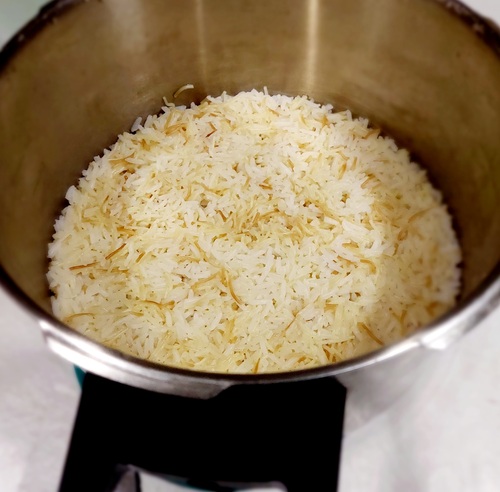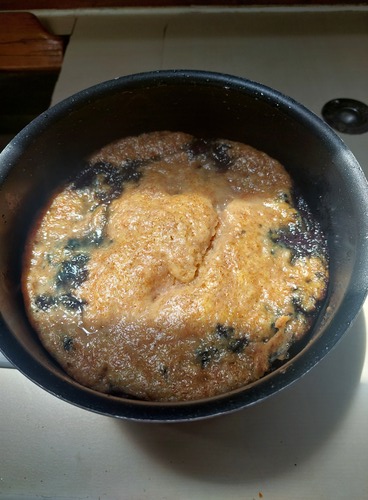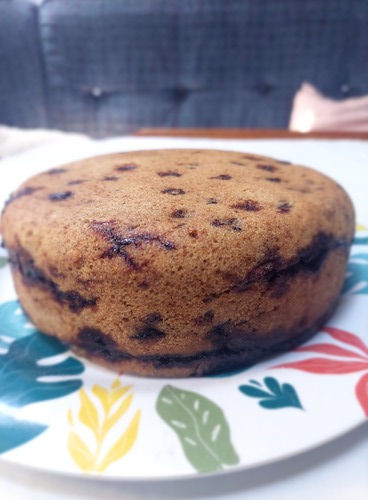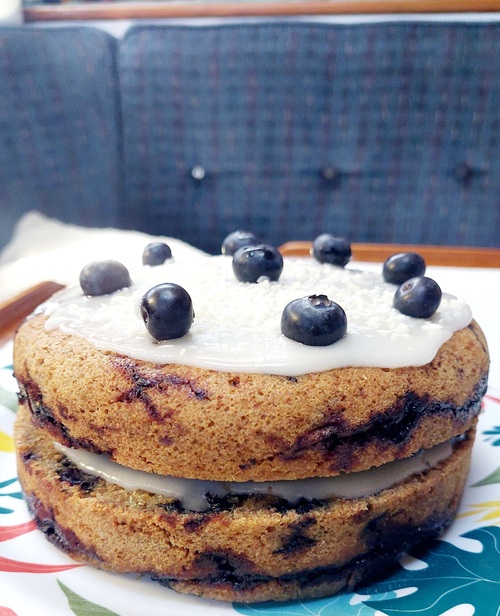INSIGHTS: Easy Pressure Cooker Recipes
If you are thinking of buying a pressure cooker for your galley, already have one on your boat or have just read Sarah Powell’s article about how the pressure cooker can revolutionise your galley, then here are some tasty recipes to whet your appetite.
Published 11 months ago
Pressure cooker recipes
The pressure cooker can revolutionise your galley game. Read my first pressure cooker article for Noonsite: How a Pressure Cooker Can Save the Galley Game
In this follow-on article, I take it to the next level by providing some of my easy-to-make sweet and savoury recipes for the pressure cooker.
Is it worth buying a pressure cooker?
A pressure cooker is probably one of the best investments you can make.
It has completely revolutionised the way I cook. Still, more importantly, the time I spend cooking means I can enjoy an impromptu dip in the water, a before-dinner game of Uno, a paddleboard with my son or a sundowner when at anchor, rather than being down in the galley preparing our evening meal.
Don’t get me wrong, the galley is my happy place and I would much rather spend my time cooking good food than eat a mediocre meal. However, the whole point of us choosing a water-based lifestyle is to spend quality time as a family and enjoy the freedom that comes with such an alternative lifestyle.
Indirectly, the pressure cooker helps me achieve that balance. I admit it takes a bit of getting used to, depending on the size and make of your trusty galley friend.


The benefits of having a pressure cooker
I find that it ticks all the boxes I need when thinking about purchasing a piece of equipment for the galley.
- Time-saving: A pressure cooker significantly reduces cooking time for your recipes, making it ideal for quick and efficient meal preparation onboard.
- Easy to clean: The straightforward design and removable parts of a pressure cooker simplify the cleaning process, ensuring minimal effort. We like that very much at Small Vegan Kitchen as we most definitely to prepare the food rather than wash up afterwards!
- Simple to use: Operating a pressure cooker involves basic steps and settings, making it accessible and user-friendly even for those new to cooking or kitchen equipment.
- Versatile: From soups and stews to rice and desserts, a pressure cooker can handle a wide range of recipes and cooking methods.
- Energy-saving: The sealed cooking environment and shorter cooking times mean you use less gas. We also like this aspect too!
What can you cook in a pressure cooker?
The possibilities are endless and the fun thing is once you build confidence cooking with a pressure cooker, then it becomes a fantastic and versatile piece of galley equipment that can really help you extend your recipe repertoire.
I started off with lentil curries, soups and stews. I also make chickpeas for homemade falafel and hummus, white beans for my delicious homemade baked beans and a mix of beans for my much-loved onboard Bean Chilli.
It has always been my go-to for rice, whether fried, boiled or risotto, and mostly hit – but sometimes miss – an easy way to cook pasta. Anyone who has tried to cook pasta in a pressure cooker will know what I mean!
More recently I have been inspired to experiment with making cakes and deserts in the pressure cooker with great success and thought I would share with you a wonderful Lemon and Blueberry Cake Recipe that is so moist and light. The first time I made it I had no plain white flour onboard, so I used the wholemeal flour I had in the cupboard. It turned out just great and the neighbouring boat were really impressed when I politely asked them to taste test it for me. That can be an advantage or a hindrance if you ever find yourself anchored near us. I may just row by with one of my creations for you to critique! So now that you are looking at your pressure cooker with intent, here are some tips and easy recipes for you to try.


Cooking Pasta
This is possibly one of the more trickier things to cook in the pressure cooker as there is no one set rule. It depends largely on the size and thickness of the pasta and if it is fresh pasta or dried.
As the pasta will continue to cook all the while it is in hot water, you need to be attentive. Here are my suggestions to keep the al dente in your pasta and not end up with soggy mush.
Add your pasta to the pan and turn on the heat. Put the lid on and as soon as the pressure gauge starts to pop up, turn off the heat and manually release the pressure from the pan according to the manufacturer´s instructions. This is probably best to do outside in the cockpit as the pan will release a lot of steam. When safe to take off the lid, do so. Strain the pasta and rinse it with cold water to prevent it from further cooking.
Cooking Rice
This is a game-changer. Whether I am making brown rice, white rice, rice pudding or risotto, this is a great way to cook it. It saves time and energy and produces great results and delicious rice no matter the application. There are a few ways of achieving great rice – here are my tips
Boiled rice method for fluffy white rice
Ingredients:
- 1 cup of rice
- 2 cups of water
- 1 pinch of salt
Instructions
- Add 1 cup of rice, 2 cups of water and a pinch of salt.
- Secure the lid and bring to boil when the pressure lid pops up (on my pressure cooker this takes about 5 mins) leave for two minutes then turn the gas off.
- The pressure cooker will release the pressure and when it is safe to do so then take the lid of and serve.
You can also manually release the pressure from the pan according to the manufacturer´s instructions. This is probably best to do outside in the cockpit as the pan will release a lot of steam.
Fried Rice
Ingredients:
- 1 tbsp oil (we use olive or rapeseed oil)
- 1 cup of rice
- 2 cups of water
- 1 pinch of salt
Instructions:
- Add 1 tbsp of cooking oil to the pan and put on medium heat.
- Add 1 cup of white rice, let it brown slightly.
- Pour in 2 cups of water and a pinch of salt.
- Put the lid on securely and let it come to pressure.
- When the pressure lid pops up (on my pressure cooker this takes about 5 minutes) leave for two minutes then turn the gas off.
- The pressure cooker will release the pressure and when it is safe to do so then take the lid off and serve.
- You can also manually release the pressure from the pan according to the manufacturer´s instructions. This is probably best to do outside in the cockpit as the pan will release a lot of steam.
Coconut and mango Rice pudding
Ingredients
- 1 cup Arborio rice (or round grain rice)
- 1 can (14 oz) coconut milk
- 2 cups plant-based milk (such as almond milk or oat milk)
- 1/4 cup coconut sugar or any unrefined sugar
- 1/2 teaspoon vanilla extract
- Pinch of salt
- Shredded coconut, (toasted if possible, for garnish)
- Fresh mango slices for serving
Instructions:
- Rinse the Arborio rice under cold water until the water runs clear.
- In the pressure cooker, combine the rinsed rice, coconut milk, plant-based milk, sugar, vanilla extract, and salt.
- Close and lock the lid of the pressure cooker. Cook at high pressure for about 6-8 minutes.
- Allow the pressure to release naturally for a few minutes, then carefully release any remaining pressure manually.
- Open the lid and stir the rice pudding. If it’s too thick, you can stir in more plant-based milk to reach your desired consistency.
- Serve the coconut rice pudding warm or chilled, garnished with toasted shredded coconut. Add fresh mango slices on top for an extra tropical flavour.
Cooking Cake
Vegan Lemon Blueberry Cake:
Ingredients:
- 1 1/2 cups all-purpose flour
- 3/4 cup sugar
- 1 teaspoon baking powder
- 1/2 teaspoon baking soda
- 1/4 teaspoon salt
- Zest of 1 lemon
- 1 cup plant-based milk (such as almond milk or soy milk)
- 1/3 cup vegetable oil
- 1 tablespoon apple cider vinegar
- 1 teaspoon vanilla extract
- 1 cup of blueberries
Instructions:
- Grease a round cake pan that fits into your pressure cooker (usually a 6- or 7-inch pan).
- In a mixing bowl, whisk together flour, sugar, baking powder, baking soda, salt, and lemon zest.
- In another bowl, mix together plant-based milk, vegetable oil, apple cider vinegar, and vanilla extract.
- Pour the wet ingredients into the dry ingredients and stir until just combined.
- Gently fold in the blueberries.
- Pour the batter into the greased cake pan and smooth the top.
- Cover the cake pan tightly with aluminum foil.
- Pour 1 cup of water into the bottom of your pressure cooker. Place a trivet inside.
- Carefully lower the cake pan onto the trivet.
- Close and lock the lid of the pressure cooker. Cook at high pressure for about 30-35 minutes.
- Allow the pressure to release naturally for a few minutes, then carefully release any remaining pressure manually.
Open the lid and carefully remove the cake pan from the pressure cooker. Let the cake cool completely before removing it from the pan. Slice and serve the vegan lemon blueberry cake, optionally dusted with powdered sugar.
These cake recipes are designed to be made in a pressure cooker and should turn out moist and delicious. Adjust the flavours and decorations to your liking, and whatever you have in your galley stores!


Cooking Soup
Butternut squash and sweet potato soup
Ingredients
- 1 small butternut squash, peeled, seeded, and diced
- 2 medium sweet potatoes, peeled and diced
- 1 onion, chopped
- 2 cloves garlic, minced
- 1 tablespoon olive oil
- 4 cups vegetable stock
- 1 teaspoon ground cumin
- 1/2 teaspoon ground ginger
- 1/2 teaspoon ground cinnamon
- Salt and pepper, to taste
- 1/2 cup coconut milk (optional, for creaminess)
- Fresh parsley or cilantro (coriander), chopped (for garnish)
Instructions
- Start by preparing the butternut squash, sweet potatoes, onion, and garlic as described in the ingredients list.
- Turn on the sauté function on your pressure cooker. Add the olive oil, chopped onion, and minced garlic. Sauté for 2-3 minutes until the onion is softened and aromatic.
- Add the diced butternut squash and sweet potatoes to the pressure cooker. Stir and sauté for another 2 minutes.
- Add the ground cumin, ginger, cinnamon, salt, and pepper to the pot. Stir well to coat the vegetables with the spices.
- Pour in the vegetable broth, ensuring all ingredients are submerged. Close the pressure cooker lid and set the valve to sealing. Cook on high pressure for 8 minutes.
- Once the cooking time is complete, allow for a natural pressure release for about 10 minutes. Then carefully release any remaining pressure manually.
- Open the lid once the pressure has fully released. Use an immersion blender directly in the pressure cooker to purée the soup until smooth and creamy. Alternatively, transfer the soup in batches to a blender and blend until smooth.
- Stir in the coconut milk to add creaminess to the soup. Adjust seasoning with additional salt and pepper if needed.
Small Vegan Kitchen Savvy Tip: If you want a more nutrient-rich soup then add a cupful of red lentils and an extra two cups of vegetable stock. This recipe is perfect for a comforting and flavorful soup that’s both healthy and satisfying. Adjust the spices and seasonings according to your taste preferences. Serve with crusty bread or a side salad for a complete meal.
Chickpea Tagine
Ingredients:
- 1 cup dried chickpeas, soaked overnight (or at least 8 hours) and drained
- 1 onion, finely chopped
- 2 cloves garlic, minced
- 1 tablespoon olive oil
- 1 teaspoon ground cumin
- 1 teaspoon ground coriander
- 1 teaspoon paprika
- 1/2 teaspoon turmeric
- 1/2 teaspoon cinnamon
- 1/4 teaspoon cayenne pepper (adjust to taste)
- 1 can (14 oz) diced tomatoes
- 1 cup vegetable stock
- 12 dried apricots or dates roughly chopped
- Salt and pepper, to taste
- 1 tbsp lemon juice
- Fresh cilantro or parsley, chopped (for garnish)
Instructions:
- Start by soaking the chickpeas in water overnight (or for at least 8 hours). Drain and rinse them before cooking.
- Turn on the sauté function on your pressure cooker. Add the olive oil and chopped onion. Sauté for 2-3 minutes until the onion is softened.
- Add the minced garlic, ground cumin, ground coriander, paprika, turmeric, cinnamon, and cayenne pepper to the pot. Stir and cook for another 1-2 minutes until the spices are fragrant.
- Add the soaked and drained chickpeas to the pressure cooker, along with the diced tomatoes vegetable stock and apricots or dates. Stir everything together.
- Secure the lid on the pressure cooker and set the valve to sealing. Cook on high pressure for 20-25 minutes (timing may vary depending on your pressure cooker and the age of your chickpeas).
- Once the cooking time is complete, allow for a natural pressure release for about 10 minutes. Then carefully release any remaining pressure manually.
- Open the lid and stir the cooked chickpea tagine. Season with salt, pepper, and lemon juice according to taste. Adjust seasoning if needed.
- Serve the chickpea tagine hot, garnished with chopped fresh cilantro or parsley. Serve over cooked couscous or rice.
Small Vegan Kitchen Savvy Tip: If you are on passage it may be easier and much quicker to use a jar or can of chickpeas. Cooking time will be just 5 minutes. This chickpea tagine is flavourful and aromatic, perfect for a satisfying and nutritious meal onboard. Enjoy your pressure-cooked chickpea tagine!
Fair winds and bon appétit!
Sarah Powell


…………………………………
Read Sarah’s Other INSIGHT articles for Noonsite:
- How a Pressure Cooker Can Save the Galley Game
- Tips and Tricks for Organzing Your Gallery
- Feeding a Family Onboard
…………………………………
Read more INSIGHTful articles on Noonsite
…………………………………
About the Author:
Sarah Powell is a full-time live-aboard cruiser currently based in Lanzarote for the forthcoming year. She passionately believes in provisioning and preparing nourishing, nutrient-rich, mood-enhancing foods to support the active and emotional adventure of living at sea and crossing an ocean.

All of the recipes and knowledge that she has learnt over the years, come from the experience gained in the galley of her previous Halmatic 30 and current Sigma 41.
Through seminars and workshops she shares, with cruisers and sailors, how it is possible to prepare delicious nutrient-dense food in the smallest of kitchens, with minimal equipment from wherever you are sailing around the world. You can read more about Sarah at:
- Website: www.smallvegankitchen.com
- Linkedin: https://www.linkedin.com/in/sarahpowellfowler
- Instagram: www.instagram.com/smallvegankitchen.com
- Facebook: www.facebook.com/smallvegankitchen
…………………………………
The opinions expressed in this article are the author’s own and do not reflect the view of Noonsite.com or World Cruising.
…………………………………
Find out all news, reports, links and comments posted on Noonsite, plus cruising information from around the world, by subscribing to our FREE monthly newsletter. Go to https://www.noonsite.com/newsletter/.


Great points on the pressure cooker. We have a fully electric galley (3kw solar, 21kwh lithium) and we often use an instant pot. It has a lot of the same benefits (plus, it adds almost no heat to the boat interior; important here in the Caribbean!), but also can be used for so many other purposes. We just used it recently to make popcorn, for example, using the saute feature and a basic lid borrowed from other cookware.
While the instantaneous draw can be high when it is heating (1500w), the total power consumed to make a meal is very low since so much of the heat is contained. Since the Instant Pot has a handle and coolish exterior, we take it to the cockpit to pressure release, keeping even more heat out of the boat.
We just found, but have yet to try, a recipe for pasta. It uses a formula based on the cook time specified on the pasta box/bag. The lowest of the time range given, rounded down to an even number, divide by 2, then subtract 2 minutes gives the cook time. Full recipe here and should be adaptable to a pressure cooker: https://inquiringchef.com/how-to-cook-pasta-in-the-instant-pot/